How do you make your whole house more energy efficient? Despite what some window companies might tell you, it’s not just about getting new windows. That is to say, new windows are a part of the energy efficiency solution, but by far not the most important or energy-saving renovation. It’s more important to recognize two things when considering home efficiency: multiple things in your home come together to make it more efficient, and often how well these features interact with each other and work together translates into just how much energy your home is capable of maintaining inside.
Obviously, different home improvements will cost differently. But how do you know which ones are the most effective when it comes to converting money spent into energy savings? As you’ll see there are several cases where you can try and calculate whether you should replace one thing or another, as well how much energy savings you can expect. Keep in mind, though, that these equations are often based on performance tests, and assume that other efficiency components in the home are working flawlessly as well. In reality, every home is different, and replacing one thing may not significantly improve the overall energy savings, and expose efficiency issues elsewhere in the house.
Here, in order of most to least efficient, is a list of home renovations that result in a more energy efficient home:
Furnace
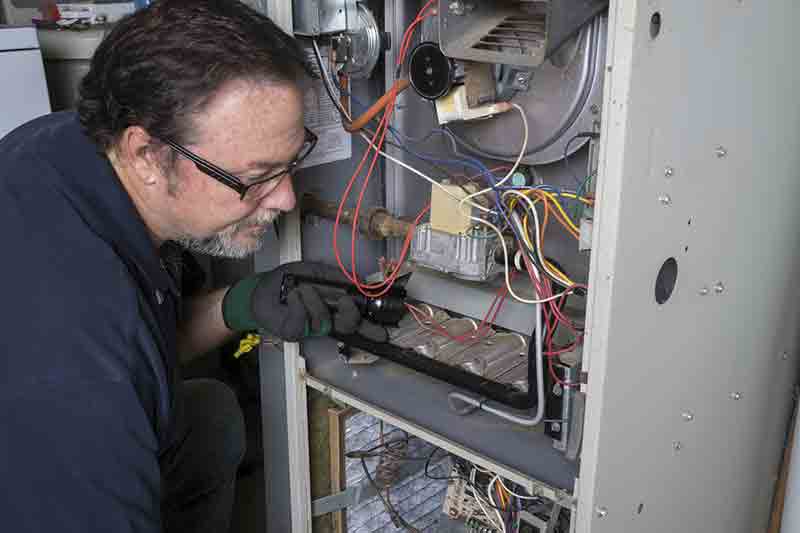
Replacing your furnace for an energy efficient one is one of the best upgrades you could get when it comes to saving money on energy bills.
Simply put, your furnace creates heat and circulates it around the house. How the heat is created depends on the type of the furnace. Some furnaces burn gas, oil, or coal. Newer furnaces make heat with an electrical element. Electrical furnaces are more efficient and require less maintenance, but are also more expensive to maintain when the time comes.
Furnaces manufactured today can operate reliably for 20-30 years, but if your existing furnace is older than 15 years, you can start thinking about a replacement soon.
One way to figure out how efficient your furnace is, and whether you need to replace it is through calculating your home’s AFUE (annual fuel utilization efficiency). If your home’s AFUE rating is below 80% you should consider replacing the furnace with a new one.
AFUE is a percentage number that represents how much of the furnace’s energy it converts into BTUs of heat. If a furnace on average turns 100 units of natural gas into 80 BTUs (as measured over a full year), then its AFUE rating is 80%.
The AFUE rating is required to be listed and visible on the furnace itself, so you can easily tell what efficiency percentage the unit operates at.
New furnaces are usually ranked by efficiency: mid-efficiency furnaces are about 80% efficient, high-efficiency furnaces are around 90% efficient, and ultra high-efficiency units can achieve up to 97% efficiency.
There are three types of furnaces available on the market today: single stage, double stage, and variable speed.
Single Stage Furnace
Single stage or single speed furnaces work continuously to create the maximum amount of heat that the furnace is designed for. Single stage furnaces have an “on” and “off” mode with nothing in between. Obviously, this can have an impact on your energy bills as the furnace pumps heat regardless of the temperature inside or outside.
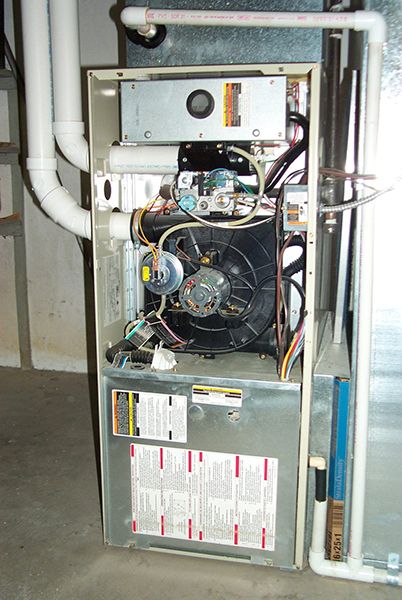
Two-Stage Furnace
Two stage or two-speed furnaces operate more efficiently. The first stage operates a majority of the time and runs at 65% of the furnace’s capacity. When the outside temperature becomes extremely cold, the second stage kicks in to provide additional heat. Because the furnace doesn’t run on high all the time, it uses significantly less energy, operates more quietly, and creates less carbon dioxide emissions for the environment.
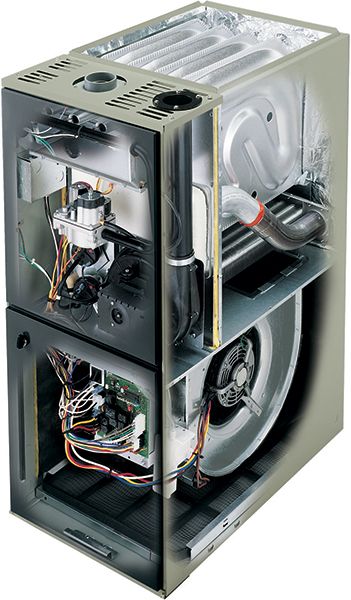
Variable Speed Furnace
With variable speed furnaces, the fan in the furnace doesn’t work on specific settings but can move at different speeds to control the amount of heated air sent into your home. Even when the furnace isn’t on, a variable speed motor can operate to circulate air throughout your home. This can help improve your indoor air quality and doesn’t require as much energy to heat your home. Modern variable speed furnaces can cost more than single or double stage furnaces, but definitely, make up the difference in energy savings over time.
If you replace your furnace with a 97% efficient system, you should cut your heating bills by roughly 20%. If you want to find out whether the furnace replacement is worth it, add up your gas utility bills for last winter, then multiply that sum by 20%. Then divide the cost of a new furnace and its installation by the resulting number, and you should get the number of years it will take for the furnace to pay for itself.
Energy Savings Formula:
(total amount of gas bills per winter) × 0.20 = A
(cost of new furnace with installation) ÷ A = B
B = the number of years it will take for a furnace to pay for itself in energy savings.
Make Sure To Check And Seal The Ducts
Before you even consider replacing your furnace, and most definitely after you replace it, you should check the condition of your existing duct system. Ducts are the tubes that deliver the heated air from the furnace to the different rooms in your house. But leaky ducts can be a major source of inefficiency, resulting in warm air escaping into the attic, crawlspace, or basement. Fixing ducts is often as simple as removing the insulation, taping up gaps where required, and re-insulating the ducts. You can also get the ducts professionally sealed by a high-tech spray that is even more effective than taping the ducts. Regardless of how efficient your furnace is, re-sealing and properly insulating the ducts in your house can give a big efficiency boost to how the air is distributed in your home, and minimize heat escaping.
Check out how much duct sealing products cost at a local hardware store
Check out this video about the benefits of aerosealing your ducts
TREND ALERT: Radiant Floor Heating
Radiant floor heating is often hailed as the answer to everything that is wrong with a forced air system. In this scenario, tubing with hot water, or an electrical element gets installed directly under your floor. There are several ways and techniques this can be done, and the type of installation often depends on your existing floors and what’s underneath them.
This way of heating your home is said to be up to 30% more efficient than running a furnace. This is in part because floor heating doesn’t lose nearly the same amount of energy that a furnace does while powering air through all the ducts in your home. A furnace also creates hot zones in your room. As warm air exits the vents it tends to rise, making the areas near the vent in your ceiling the warmest, while not necessarily heating all of the living space. With floor heating, warmth is distributed evenly throughout the whole floor and rises from there. This results in a more balanced temperature in the whole room. The diagram below explains this.
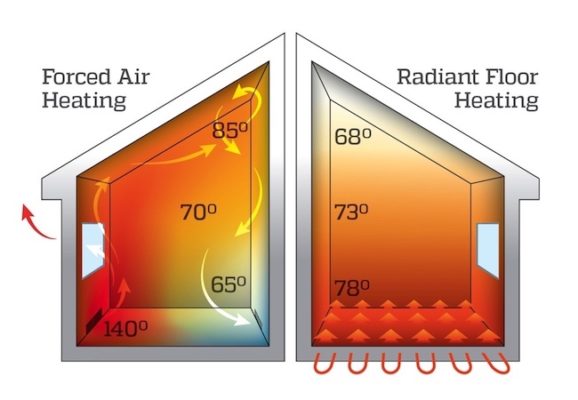
Because there is no air to move around, radiant floor heating is also a lot healthier as allergens and dust particles don’t get circulated through your home the way they do with a forced air system.
In floor heating costs depend on where the heating is to be installed, what floor already exists in the room, and whether the project is done in a new construction home or a retrofit.
Check out some examples of how much installing heated floors can cost.
Roof Insulation
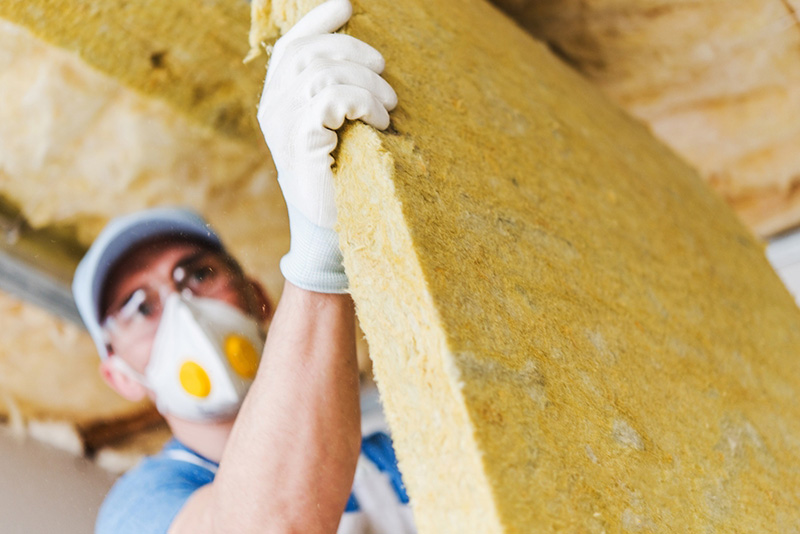
Because the warm air in your home rises, it can often escape through the attic and the roof. That’s why roof insulation can be almost as crucial as a furnace replacement in your house. Even with a new furnace, heat may still escape if the attic and the roof aren’t properly insulated.
The best roof insulation for a home depends on a number of factors including cost, how easy it is to install, and what R-ratings are required for the home. The R-value is a measure of how resistant a material is to heat movement through it. The higher the R-value the better an insulating material is. Local building codes also list recommended R-values for each area of your house. These R-values are also required to be met in new construction properties. Keep in mind, incorrect installation of insulation can reduce the R-value of the insulation. That’s why it may be a good idea to hire a professional to add or install insulation in your home.
Types of Insulation:
Fiberglass
$$$
R-value per inch: 3.0-3.7
Fiberglass is the pink material most people are familiar with. It is manufactured from recycled glass or sand that’s melted and turned into fibers. Fiberglass usually comes in “batts,” pre-packaged rolls or packs that can be laid side by side and on top of each other to insulate and area. Most home improvements stores sell fiberglass batts in the event you want to do the insulation yourself. Loose fiberglass is also an option but should only be installed by a professional to get the most benefit. In this scenario, the fiberglass gets sprayed into the opening. A professional spray will ensure the insulation is applied evenly for best results. Fiberglass is lighter in weight than cellulose or mineral wool but settles more, so it requires a thicker layer for proper insulation, hence more material needs to be used.
You can see how much fiberglass insulation costs at a local Home Depot here.
Mineral fibre
$$$
R-value per inch: 2.8-3.7
Like fiberglass, mineral fiber often comes in batts and is easy to work with and widely available. Loose-fill mineral fiber is also available.This fiber is manufactured from rock or recycled slag from blast furnaces. Mineral fiber is more fire resistant and has better sound-proofing capabilities than other materials, but also costs more than other loose-fill materials.
Check out how much this type of insulation costs.
Cellulose
$$$
R-value per inch: 3.2-3.8
Cellulose is only available as a loose-fill material and is generally used in attics because it is denser than fiberglass or mineral fiber. It is made from recycled post-consumer paper that is treated for insect and fire resistance. Cellulose is the most common blown-in material, but it can grow mold and rot if exposed to moisture.
See pricing options on cellulose insulation from a local hardware store.
Rigid Foam
$$$
R-value per inch: 4.5-5.0
Rigid foam comes in expanded polystyrene (EPS) or extruded polystyrene (XPS) and is used on the shell of your home under your siding. It is also used to line exterior basement walls and insulate the slab. Both EPS and XPS offer good R-values over time, aren’t susceptible to mold growth, and can be installed in wet areas.
Get prices for rigid foam insulation at Home Depot.
Spray Foam
$$$
R-value per inch: 5.5-6.0
Spray foam is one of the more popular insulators in both new construction and renovation projects. There are two main types of foam: a low-density open-cell polyurethane and a closed-cell polyurethane that is of a higher density. Closed cell foam is a more popular choice for attics and exterior walls. A big benefit of spray foam is that it helps create a stronger, more airtight home, and is resistant to mold growth. It is recommended that spray foam insulation is installed by a professional to get full benefits and the best energy-efficiency for your home.
Find out the cost of spray foam insulation
You can see the full table of insulating values for all common household materials on this Natural Resources Canada website.
Replacement Doors
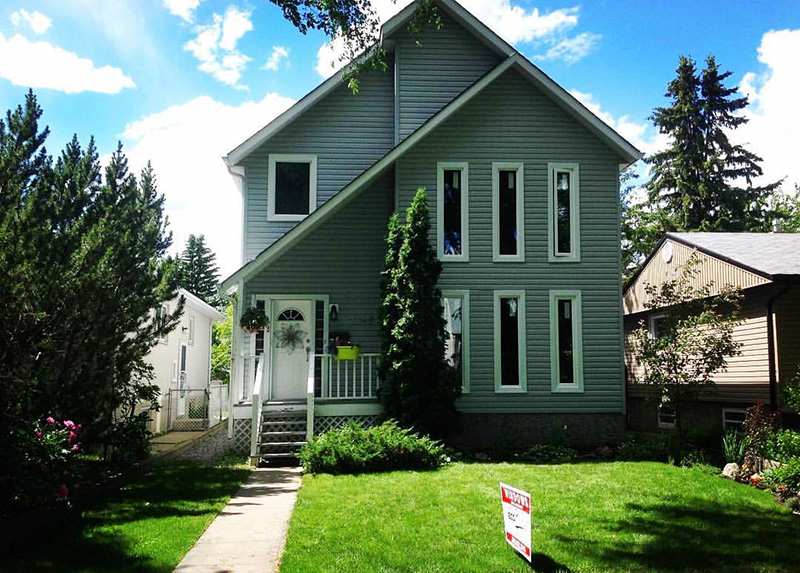
Get a Free Quote On Energy-Efficient Entry Doors
Homeowners often talk about replacement windows as the solution to their efficiency woes, but quite often much more energy loss in a home occurs through the entry doors than through the windows. Entry doors don’t always have the same airtight technology used in modern windows. Doors also get used and abused much more than windows, and over time they can deteriorate, become misaligned, and lose even more heat. If a door does not fit snugly into the frame, there is a good chance it will lose warm air and allow moisture in.
It is crucial for the proper operation and efficiency of the door, that it is installed square and plumb. Even minor misalignments from level can cause leaks and drafts and significantly ruin the efficiency of your entry doors.
Modern entry doors are usually manufactured from a combination of wood, steel, and glass. What is crucial, is that your door is installed correctly so that it is properly aligned and allows for minimum air escape.
Doors rely on weatherstripping to keep warm air in, and cold air and elements out. Even with old doors, it is possible to get some of the efficiency back replacing the weatherstripping with the new one around the perimeter of the frame where the door closes. The most effective weatherstripping for a door frame is quality V-shaped vinyl tape. It makes contact with the edge of the door and provides a good seal even when the door warps from season to season.

Apply weatherstripping to either the door sill or a door sweep on the door itself. Although this can be a difficult area to seal well, it is worthwhile doing because this is often a source of major drafts. Use durable material that can withstand traffic and is flexible enough to conform to changes in the door caused by fluctuations in humidity and temperature.
Check out the consumer’s guide to buying Energy-Efficient Windows and Doors in Canada.
Windows
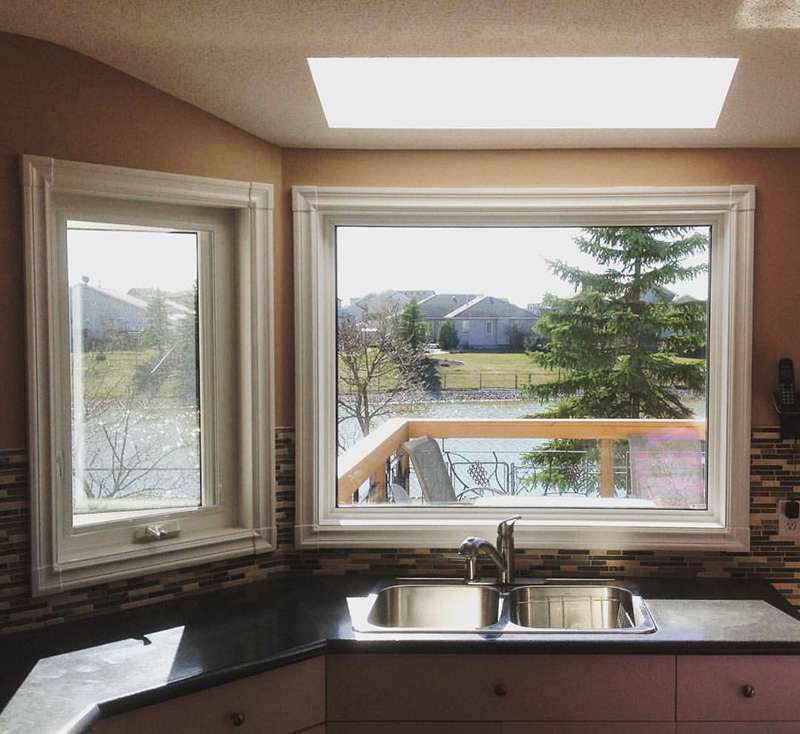
Get a Free Quote On Energy-Efficient Windows
There is no doubt that windows can contribute significantly to keeping warm air inside your home. Besides the window itself being efficient, a correct window installation is supposed to seal off your wall structure from any water or moisture causing damage over time.
How do you ensure that the windows you buy are energy efficient?
The best way to get energy-efficient windows is to buy products that are Energy Star rated and NAFS tested. Energy Star is an international organization that rates household appliances and building materials based on their energy efficiency performance. As of January 2020, homeowners no longer have to consider a Climate zone when shopping for windows that are ENERGY STAR® certified in a particular area. A product in Canada is either ENERGY STAR® certified or not, with a single standard applied nationwide.
But keep in mind that if you are looking to purchase new energy-efficient windows, you should only consider models with a minimum ER (energy rating) of 34 to make sure that these windows meet the Canadian government fenestration standards.

ER or a window’s Energy Rating is a number that is calculated based on how well the window prevents heat escaping through conduction, air heat loss, and how much energy a window gains from The Sun.
Although the ER rating is a common way to rank windows, for customers in Canada it is perhaps more important to buy windows with a good U-Factor. The U-factor takes into the consideration how well the window keeps heat from escaping. This is especially important in Canada where there isn’t a lot of sunlight. While a window may be considered more efficient because it gains more energy from the Sun, in areas where there is little sunlight in the winter, it is more important to keep heat in. Thus the U-Factor may be a better indicator of how well the windows will perform once installed.
Water Heater
A big contributor to energy costs in a home is the use of water heater. As per Environment And Climate Change Canada, on average, a Canadian uses roughly 251 liters of water per day.
Today, there is a variety of water heaters available to homeowners: conventional storage, demand, heat pump, tankless coil, indirect, and solar.
While homeowners often purchase water heaters based on the size of the tank, a more appropriate measure of how well a water heater works is its peak hour demand capacity or the first-hour rating (FHR) as it’s referred to on the Energy Guide label. The FHR measures how much hot water the heater will deliver during a busy hour and is required to appear on the heater’s labeling. Ideally, you would estimate your household’s peak demand and look for a unit with an FHR in that range. It is determined by how many bathrooms and bedrooms you have in your house. For example, a 3 bedroom 2 bath house has an FHR of 253 liters as a minimum. Keep in mind, also that a water heater can’t deliver 100% of it’s hot water capacity on demand. Allow for some buffer room when deciding on a new water heater and get one that is bigger than your minimum FHR.
Storage Water Heaters
Storage water heaters are what they sound like. The heater collects a certain amount of water and continually keeps it hot. When the faucet is turned on, the heater operates by releasing water from the top of the tank. To replace the hot water, cold water is then filled at the bottom of the tank. These heaters can range in size from 75 to 302 liters and have been the traditional choice in many homes. These heaters can waste quite a bit of energy because the heater is always working, even when the faucet isn’t turned on. This is known as standby heat loss. Storage water heaters usually work on one or a combination of natural gas, oil, electricity, or propane.
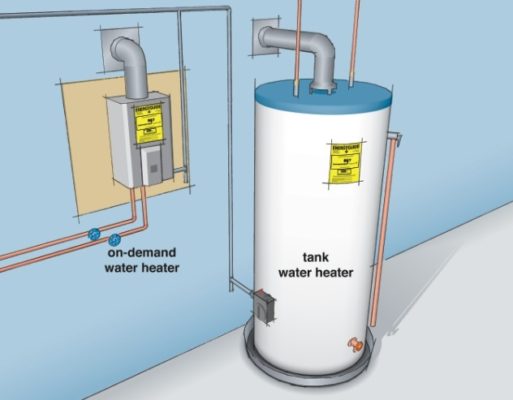
Demand Water Heaters
Newer water heaters can significantly reduce standby heat loss, making them less expensive to operate. It is possible to eliminate standby heat losses from the tank and reduce heater energy consumption by 20-30% percent with demand (or instantaneous) water heaters, which do not have storage tanks. In demand heaters, the cold water travels through a pipe into the unit, and either a gas or electric element heats the water as needed. With these systems, you never run out of hot water, but their flow is much more limited than storage tanks.
Demand water heaters supply hot water at a rate of 7-15 liters per minute. This may be enough if you’re not using hot water at more than one location in the house. To solve this problem it is possible to install several demand heaters to run in sequence. Electric demand water heaters range in size from sink-mount ones to the whole house. Gas powered demand heaters have higher flow rates than electric ones but can still waste energy as they generally require the pilot light to stay on. There are also gas water heaters with pilotless ignition available on the market.
Electric vs. Gas Water Heaters
Gas water heaters have a higher FHR than electric ones with the same capacity. Therefore it may be easier to meet your water heating needs with a smaller gas unit than an electric one. Because more efficient gas heaters often utilize additional arrangements, this can increase the installation costs.
If you currently have an electric water heater and considering getting a gas one, keep in mind the costs associated with running a gas line to the heater, and a vent pipe to the outside of the home. Similarly, when converting from gas to electric, consider the cost of wiring the water heater and whether your current electric service can handle the additional load.
Electric Heater Pros:
- safer than gas, no gas leaks to worry about
- fewer parts to install, repair and replace
- lower installation cost
- generally last longer than gas heaters
- can be programmed
Gas Heater Pros:
- Better water flow
- Cheaper to operate
- Because gas heaters are more efficient than electric, they make up the difference in a higher installation price in a year or two.
Water Heater Efficiency
The best way to determine a heater’s efficiency is by its Energy Factor (EF) which is based on how efficiently the heat from the energy source is transferred to the water, standby losses, and cycling losses. The higher the EF number, the more efficient the water heater.
Electric Resistance Heater EF: 0.7-0.95
Gas Heaters EF: 0.5-0.8
A heater manufacturer should be able to provide the EF information on the heater.
Check out this Guide for Purchasing Water Heaters In Canada.
Above, we’ve mentioned some of the biggest renovations you can undertake to improve the efficiency in your whole house. As was said, the efficiency in your home often depends on all these components working well together and relying on each other to fulfill the efficiency needs of your home.
Learn everything you need to know about replacement windows:
Find out how much a new windows project should cost
Landscaping and energy efficiency of your home
See how the human factor contributes to energy waste in your home
Get a Free Quote On New Windows

